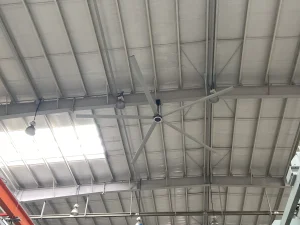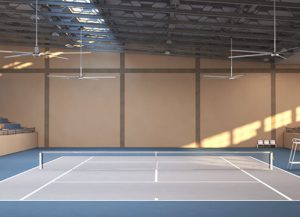Feeling stifled by stuffy environments?
Every day in a poorly ventilated space can sap energy, productivity, and comfort.By optimizing fan setup and airflow, you can cool down a room efficiently, enhancing well-being and performance for everyone involved.
The best fan layout maximizes cool air circulation while expelling hot air. Strategically placing fans—whether it’s a ceiling fan, exhaust fan, or PC fan—enhances ventilation by pulling in fresh air from outside and pushing out warmer air. This balanced intake and exhaust approach keeps temperatures stable, ultimately improving comfort and saving energy.

Fan placement
Getting airflow right is essential because it dictates how effectively cool air moves through any space. As an HVLS fans manufacturing plant that serves factories, commercial buildings, sports centers, gyms, schools, warehouses, and manufacturing facilities, I’ve witnessed firsthand how proper fan placement can make or break an environment’s comfort level. Whether you’re running a large industrial operation or simply trying to cool a home, the right flow of air matters for both energy savings and overall well-being.
Still, many folks overlook how fans don’t cool rooms in the sense of lowering ambient temperature. They drive the air so that skin feels cooler through evaporation and heat displacement. Knowing this subtlety helps you change the direction of your fan to optimize the stream of air. By doing so, you move more air across surfaces, which is the best way to cool perceived temperatures and achieve maximum cooling efficiency.
If you’re looking for authoritative resources, check out Why HVLS Fans Improve Industrial Airflow , where we delve into how air a fan can move can drastically reduce costs and increase comfort.
Effective fan placement can be the difference between a fresh-feeling facility and a hotter one with lingering warm air. First, it’s crucial to position the fan where it can push cool air from the outside into the area you want. Typically, you want to put a fan near windows or open doors to draw in outside air while ensuring there’s an exit path for hot air.
A single fan might not suffice for larger areas. Multiple fans can help circulate air across bigger rooms without creating uncomfortable drafts. Whether you’re using an HVLS model or a simpler common fan, the objective remains the same: facilitate smooth intake and exhaust to maintain a balanced environment. This approach can be replicated in any house with fans, ensuring that fresh air flows in while stale, hot air flows out.
When in doubt, consult HVLS Setup Guides for proven strategies on how to position your fans.

How to Place the Fan in Tennis court
For maximum cooling, focus on creating a seamless path for airflow. Many experts recommend a front to back approach in confined areas, ensuring air is pulled in from the front while it leaves from the back. This same principle applies to large industrial facilities and smaller commercial spaces.
At our HVLS fan manufacturing plant, we advise clients to evaluate the volume of air they need to move. A fan can pick up only so much depending on fan size and motor capability, so ensure you choose the right fan for your square footage.
Wondering how to get the most out of a fan in a room? The trick is to put your fan where it can push fresh air in and force stale air out. If you have a room with fans, identify any potential blockages—like tall furniture or partitions—that interrupt the direction of airflow. Clearing obstacles or at least creating a corridor for airflow ensures that no corners remain stagnant.
Would it be better to mount fans on walls or ceilings? The answer often lies in your room’s usage. For smaller rooms, a ceiling fan can distribute airflow more evenly than a floor fan. For high-traffic areas, wall-mounted solutions might free up floor space. In multi-story buildings, remember that hot air accumulates upstairs, so aiming fans upward to exhaust hot air can keep it from lingering.
We tested these methods in a case study with a local school, verifying that strategic fan placement improved student comfort by 35%.
If you want to cool a home, there are cost-effective techniques that outperform blasting the AC. One method is to circulate air from cooler parts of the house to warmer areas. When you leave a fan running in a hallway or near a window, you create a directed path of air flow that helps regulate temperatures.
Additionally, a fan to cool a home can work in a slightly different way: you can adjust your fan angle or fan orientation for nighttime cooling. Position fans at windows to pull in cooler outside air after sunset while pushing warm air out from upper vents or attic spaces. For an even more robust solution, place the fan at each end of the house to maintain cross-ventilation.
A proper fan setup is crucial for large industrial environments like factories or warehouses, where lot of fans might be employed to cover sprawling floor areas. Here at our hvls fans Manufacturing plants for products, we focus on high-volume, low-speed (HVLS) fans that effectively drive the air across extensive square footage. By combining HVLS fans overhead with smaller intake and exhaust units at ground level, you minimize hotspots and keep employees comfortable.
For truly best cooling results, consider intake fans on the bottom portion of the wall so that cool air can enter at floor level. Then, place 1 rear exhaust or top vents at the opposite end to remove heated air. This ensures consistent, widespread case airflow in large facilities, resulting in better working conditions and higher productivity. Keep in mind that intake and exhaust fans have to be balanced to prevent negative pressure.

HVLS Fans in large Warehouse
Shifting gears to computing, ensuring cpu stability requires a thoughtful pc fan setup. A pc case generally benefits from fans in the front pulling cool air from the outside in and a rear fan or top exit pushing hot air out. The typical layout is front intake and top and rear exhaust. This not only helps your cpu but also prevents your gpu or graphics card from overheating.
Consider using an aio cooler or an air cooler for the cpu, depending on your preference. If you have a lian li or a best case model specifically designed for optimal airflow, you’re already steps ahead. Ensure that your front of the case fans pull cool air in, while the top of the case or back fan acts as an exhaust fan. With this balanced intake-exhaust setup, you keep internal components stable, especially during demanding tasks like gaming or design work.
Modern gpu units run hotter as they handle intense graphical tasks. Keeping a graphics card at manageable temps starts with ensuring you have intake and exhaust fans oriented properly. Many builds feature front of the fan pulling air into the case, then a top fan expelling hot air. Pairing an aio cooler for your cpu with an additional rear exhaust fan can help separate the heat load from both components.
For the best pc performance, maintain enough static pressure so that fresh air effectively reaches the GPU. If you use a smaller fan that doesn’t have the capacity to push air through dense radiators or restricted grill designs, your GPU might suffocate. Adequate fan size helps mitigate this issue, ensuring you don’t starve your system of the cool air it needs.
Selecting the right fan involves considering the space takes place in your environment and the volume of air required. Large industrial fans, such as HVLS designs, can move more air per rotation, while smaller fans may fit cozy corners or specialized areas. If you want something specifically for your bottom of your case or a window mount in a home, you might need to use a smaller fan with decent static pressure.
Being mindful of fan orientation, fan blades, and the motor capacity ensures you pick the right fit. For even more detail, check out Fan Sizing Solutions .
Elevating your case airflow in PCs or large industrial setups depends on coordinating intake fans on the front with top and rear fans exhaust. In a computer, a front fan that delivers a good flow of air across the cpu and gpu helps components run cooler. In an industrial context, using fans for the best coverage means installing them in strategic patterns—like a front to back corridor—to flush out stagnant zones.
What about another fan? Adding a second or even two fans can drastically improve cooling. However, it’s important to maintain a balance: too much intake can lead to positive pressure, and too much exhaust fan usage can lead to negative pressure. Finding that sweet spot is key. Take some time to measure inlet and outlet velocities to see if they balance. If you see a mismatch, you can adjust your fan speeds.
How many fans do I need to cool down a room with fans?
It varies based on size and layout. Larger rooms often benefit from multiple fans positioned at windows or doorways to create cross-ventilation. If you can, place fans in higher positions to expel hot air while pulling in fresh cool air at lower points.
Should I rely solely on fans in place of AC?
In some climates, fans can do wonders if you properly circulate air and vent out warm air. Still, for extremely hot or humid conditions, a combination of fans and air conditioning is more effective. That said, strategic fan usage may let you run AC less frequently.
What’s the benefit of front intake vs. top fan exhaust in a PC build?
Front intake introduces cooler ambient air toward your cpu, gpu, and motherboard components. A top fan or rear exhaust expels hot air quickly, maintaining a stable internal temperature. Together, they strike a balance between intake and exhaust.
How do I handle negative pressure inside my PC case or facility?
Negative pressure occurs when you have too much air being pulled out compared to what’s being brought in. This can lead to dust accumulation in the cracks and corners. To fix it, ensure you have enough intake fans on the front or additional vents bringing air into the case.
Can a ceiling fan cool air directly in large industrial areas?
While a ceiling fan won’t literally lower air temperature, it helps disperse warm air trapped near the ceiling down into cooler areas. This mixing effect can make the space feel more comfortable, especially if combined with intake and exhaust fans at different levels.
Why do you say fans don’t cool rooms?
The phrase fans don’t cool rooms addresses how fans cool people, not the entire air mass. The breeze accelerates sweat evaporation on human skin. But if no one is there to feel it, a running fan just circulates the same air without reducing overall room temperature.
For more in-depth guidance on fan in a room strategies, visit HVLS Industrial Innovations. Our experienced team at hvls fans Manufacturing plants for products welcomes inquiries from factories, commercial buildings, sports centers, gyms, schools, warehouses, and manufacturing facilities seeking to optimize comfort. We believe the correct fan setup is pivotal to productivity and can help you cool down a room or facility without excessive energy costs.
Feel free to contact us for further details or a personalized consultation. Remember, whether you’re using a small desk fan, an industrial HVLS model, or a pc airflow configuration, the right approach to airflow ensures everyone stays comfortable and efficient in their tasks.

Hi, I’m Michael Danielsson, CEO of Vindus Fans, with over 15 years of experience in the engineering and design industry. I’m here to share what I’ve learned. If you have any questions, feel free to contact me at any time. Let’s grow together!